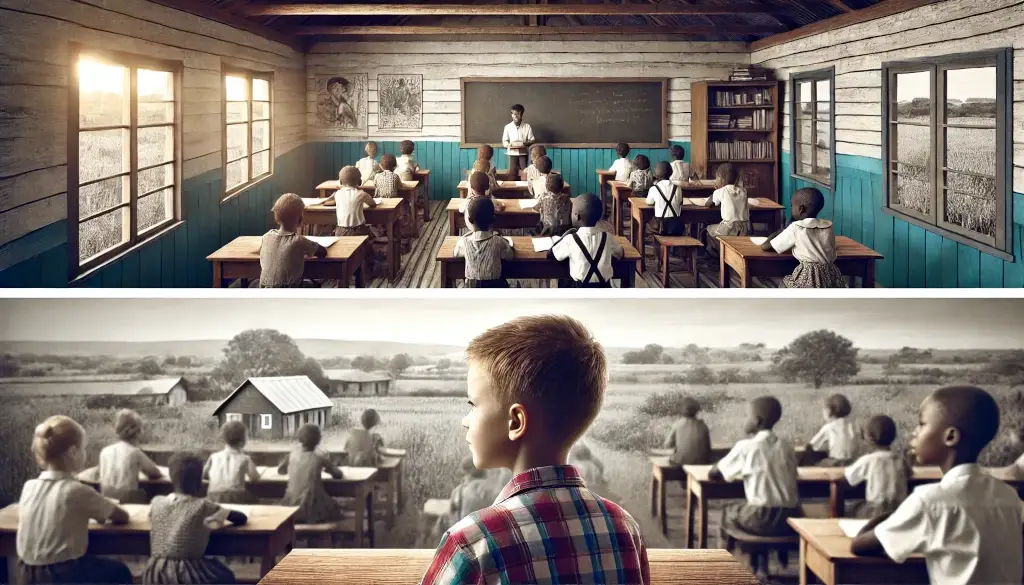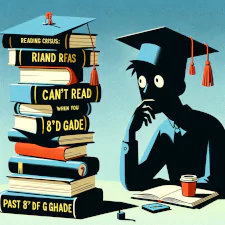John was born in 1970:
In rural Mississippi, where education wasn’t always a priority, especially for kids like him who came from low-income working-class families. By age 7, John still couldn’t read, and though he was bright and quick with his hands, reading just didn’t come naturally to him. As he grew older, he found himself relying on his street smarts to navigate life, avoiding situations that required reading whenever possible.
According to a recent study from the Department of Education, roughly half of U.S. adults, aged 16 to 74 years old — 54% or 130 million people — lack literacy proficiency.
This is the story of John’s journey—how he survived in a world built on literacy and how his inability to read shaped his life in unexpected ways. Through John’s struggles and triumphs, we explore the impact of illiteracy in the United States and how one man’s determination to overcome it changed his future.
Table of Contents
- Introduction: The Early Years
- Early Challenges and Family Life
- Surviving on Street Smarts
- Struggling with Expectations in High School
- First Real Consequence: Job Opportunities
- Leaning on Street Smarts for Survival
- Missed Opportunities and Growing Frustration
- Life Without Reading: A Daily Struggle
- The Big Setback: Health Crisis
- Turning Point: Seeking Help
- Facing the Fear: First Steps Toward Literacy
- New Opportunities Through Literacy
- The Road Ahead
- Resource Materials:
Introduction: The Early Years
John was born in 1970 in Mississippi, a state where education resources were often stretched thin, especially in rural areas. By the time John turned 7 in 1977, it was clear that reading didn’t come easily to him. His classmates could read simple sentences; they sounded out words, tracing their fingers along the lines of school books. John, though, couldn’t make sense of the letters on the page.

In school, he struggled quietly. He was smart in other ways—he could memorize conversations and was quick to pick up on how people acted around him. His teacher noticed that John was great at following spoken instructions, but when asked to read aloud, he stumbled and felt embarrassed. No one knew then, but John’s reading struggles would follow him throughout his life.
At that time, illiteracy in the United States was a growing concern, especially in the South. The illiteracy rate in the U.S. was around 4%, but in poorer regions like Mississippi, it was much higher, especially for people like John, who came from low-income, working-class families.
Early Challenges and Family Life
John’s parents worked long hours, and like many others in their community, they had limited education themselves. His father didn’t read much, and his mother was busy keeping the house in order. At home, there wasn’t much help with schoolwork.
Try Harder
By the age of 10, John knew he wasn’t like the other kids. He understood numbers well enough to help his father with the family’s small yard work business, but reading the newspaper or filling out simple forms seemed impossible. His teachers said he just needed to “try harder,” but no amount of effort made the letters stay still on the page.
Without understanding the formal term for it, John was facing illiteracy, a condition that was more common than many people thought. He wasn’t alone—illiteracy in adults across the U.S. was prevalent, with millions struggling in silence. Even though the literacy rate in the United States was rising, the reality was that many adults still faced major reading challenges, especially those from disadvantaged backgrounds like John’s.
Surviving on Street Smarts
By the time John reached middle school, he had learned how to survive without reading well. At 13, he relied on his sharp memory and quick thinking to get through most situations. He could figure out which bus to take by watching others, and he managed at school by listening carefully. He used his street smarts to dodge questions in class and avoid embarrassment. When it came to reading tests or assignments, he would often copy what others did.
Though illiteracy in the U.S. was a quiet epidemic, John didn’t think of himself as someone with a learning disability. He just knew reading wasn’t his strong point. Besides, he was good at understanding people and solving problems on the fly—things he felt mattered more in real life.
John wasn’t the only one who struggled with this. Even as he grew older, many of his peers had similar problems with reading. The illiteracy rates in the United States were higher than what many people thought, particularly in rural and low-income areas. People like John often used their wits to survive, but it still limited their opportunities.
Struggling with Expectations in High School
As John entered high school, the pressure to perform academically grew. Reading assignments became longer, and teachers no longer had the patience to help him. His street smarts couldn’t always get him out of tough situations. He started skipping class when he knew there would be a reading exam, relying on friends to fill him in on what he missed.
By 16, John had learned how to “blend in” without anyone really noticing his struggles. He had a natural charm, and his ability to talk his way through conversations helped him avoid direct questions about schoolwork. When it came time to read aloud in class, he’d quickly scan the room for someone to help him. But deep down, he knew that these tactics wouldn’t work forever.
Illiteracy in the U.S. at this time was a hidden struggle for many teens like John. The literacy rate in the United States was improving overall, but this masked the struggles in pockets of the country, particularly in rural or underfunded school districts. For kids like John, who came from poor, working-class families, the educational system didn’t always offer the right support.
First Real Consequence: Job Opportunities
By the time John turned 18 in 1988, it was time to leave high school and think about what came next. He’d barely passed, and even that was because of a lot of help from friends and teachers who didn’t want to see him fail. He wanted to find a steady job, something that didn’t require too much reading, but even simple tasks like filling out job applications were a challenge.

One day, he walked into a local mechanic shop, hoping to land a job. He had experience fixing cars with his dad, and he knew he was good with his hands. The manager handed him a paper application, asking him to fill it out. John stared at it, his palms sweaty. The words blurred together, and the technical terms made no sense. He quietly asked the manager if he could take the form home and “think about it,” but he never went back.
John’s story isn’t unique. Even in the late 1980s, illiteracy rates in the United States were higher than many people realized. Illiteracy in adults was particularly concerning for people entering the workforce, as it limited job opportunities and financial growth. Employers often dismissed individuals like John without understanding their struggle.
Leaning on Street Smarts for Survival
John adapted, as he always did. Instead of applying for formal jobs that required paperwork, he took odd jobs—mowing lawns, fixing cars, and running errands for people around town. His street smarts helped him figure out how to negotiate for better pay and manage his own small business without the need for complicated contracts or forms. He was a hustler in the best sense of the word, and he thrived in situations where quick thinking and adaptability were key.
But no matter how hard he worked, John knew he wasn’t getting ahead. His lack of reading skills kept him in low-paying, under-the-table jobs. The illiteracy of the United States wasn’t just a problem for kids in school—it was a lifelong challenge for people like John who were left behind by the system.
Missed Opportunities and Growing Frustration
As John entered his late twenties, he watched as his peers moved forward in life. Some got stable jobs in factories or offices, and others went to college or moved out of town for better opportunities. John, still unable to read more than a few words at a time, felt stuck. His jobs paid just enough to get by, but he always struggled to keep up with bills. He started to see that no matter how smart he was with people, his lack of literacy was holding him back in life.
In his early thirties, John tried to apply for a job at a local construction company. He had the skills they needed—he’d spent years doing manual labor and knew his way around tools better than most. But when the foreman handed him a safety manual to read before getting started, John felt the same wave of panic he’d experienced back in high school. He couldn’t make sense of the words.

Embarrassed, he handed the manual back and made an excuse about needing more time. That job slipped through his fingers, and so did many others that required even basic reading comprehension. Illiteracy rates in the United States were often higher than reported, and people like John lived on the margins of society—capable, and smart, but limited in opportunity because they couldn’t navigate the world of words.
Life Without Reading: A Daily Struggle
Everyday tasks that most people took for granted were hurdles for John. When he went to the grocery store, he had to rely on the pictures on the packaging to know what he was buying. He would recognize logos and brands, but the nutrition labels and ingredients were a mystery. Reading street signs was nearly impossible, so he memorized landmarks instead.
John could keep up in conversations and could even talk his way out of difficult situations, but not being able to read limited his independence. He couldn’t sign up for services without help, and simple things like filling out government forms were a nightmare. When voting season came around, John relied on word-of-mouth information, since reading through the ballot or the candidate information was overwhelming. This was a reality for many others like him, with illiteracy in the U.S. affecting how people engage with society.
The Big Setback: Health Crisis
John’s inability to read reached a critical point when he was 35. After experiencing persistent pain in his side, he finally went to the doctor. The diagnosis wasn’t good—he had a condition that required ongoing medication and strict management. The doctor handed him a prescription and a long set of instructions, but John couldn’t make sense of it. He tried to nod along, pretending to understand, but inside, he was panicking.

At the pharmacy, John asked the pharmacist to explain the medication, but once home, the bottle’s label confused him. He mixed up the dosage and took too much, leading to a severe reaction that sent him back to the hospital. This was the first time he truly realized the danger of not being able to read. It wasn’t just about job opportunities or finances anymore; his health was at risk.
Illiteracy in adults could lead to life-threatening situations, and John’s experience was no different. Many adults in the U.S. struggle with health literacy, a problem deeply tied to illiteracy rates in the United States. Not being able to read and understand medical instructions can have serious consequences, just as it did for John.
Turning Point: Seeking Help
After his health scare, John started to think seriously about what he was missing out on by not being able to read. He had always relied on his street smarts and practical intelligence, but he realized that his inability to read was now a serious limitation in his life. He couldn’t handle important documents on his own, couldn’t vote confidently, and now, even his health was at risk.
It Wasn’t Easy To Admit
John knew he had to do something. He started talking to people about his struggles, something he had never done before. A friend told him about an adult literacy program offered at a community center in the next town over. John was hesitant—he was a grown man, and the idea of going back to a classroom felt humiliating. But he couldn’t keep relying on others to navigate life.
Illiteracy in adults was a problem for many, but adult education programs across the country were designed to help people like John regain control of their lives. Programs like these were part of a larger effort to improve the literacy rate in the United States, but they required people to take the first step, just as John was about to do.
Facing the Fear: First Steps Toward Literacy
The first day John walked into the community center, he felt out of place. The room was filled with adults of all ages, some older than him and some much younger, but all with one thing in common: they couldn’t read well. The teacher, a kind woman in her 60s, greeted him warmly and reassured him that he wasn’t alone.

Learning to read as an adult was harder than John expected. He wasn’t used to sitting still and focusing on letters and sounds. His mind raced as he tried to connect the words on the page with their meanings. He felt frustrated like he should’ve been able to grasp these basics long ago. But he stuck with it.
Slowly, John started making progress. The first time he read an entire paragraph on his own was a small victory, but it felt huge to him. He began to realize that his illiteracy wasn’t a reflection of his intelligence—it was something he could overcome. The program helped him learn strategies for understanding words and sentences, and over time, reading became less of a chore and more of a possibility.
New Opportunities Through Literacy
As John’s reading improved, so did his confidence. For the first time, he was able to read job applications without asking for help. He understood the documents he signed and could read instructions for simple tasks like filling out forms or paying bills. He even began to follow political news more closely, which made him feel more informed during election season.
One day
John applied for a job at a local factory, and this time, when the manager handed him a form, he filled it out on his own. It was a huge step forward. He got the job and was able to support himself better than before.
Improving adult literacy wasn’t just about learning to read—it was about changing lives. The literacy of the United States was slowly improving, thanks to programs like the one John attended, but there was still a long way to go. People like John were living proof that investing in adult education made a difference, not just for individuals, but for society as a whole.
The Road Ahead
Though John’s journey was far from over, he was no longer trapped by his inability to read. His street smarts, which had helped him survive for so long, were now paired with new reading skills that gave him even more power over his life. He still struggled with some complex texts, but he could handle most day-to-day reading tasks.
End of Part 1
As John reflected on the past, he realized how important literacy was to all aspects of life. Whether it was about understanding medical information, applying for jobs, or participating in democracy, reading was the key to accessing these opportunities. John’s story was just one example of the many adults in the U.S. who had faced similar challenges.
This concludes the first part of John’s story, leading up to his efforts to seek help and improve his life through literacy. The next part will dive deeper into how his new skills impact his life, the social issues surrounding literacy in the U.S., and the broader societal benefits of improving illiteracy rates in the United States.
Resource Materials:
National Center for Education Statistics (NCES): The NCES provides comprehensive data on adult literacy in the U.S., including trends in adult education and the barriers many face in accessing literacy programs. This resource can provide context for those who struggle, especially regarding how common low literacy rates are.
ProLiteracy: ProLiteracy is a nonprofit organization dedicated to improving adult literacy in the U.S. They provide resources for adult learners and advocate for stronger community-based literacy programs, making it an excellent resource to reference for those seeking help.
The Literacy Project: This organization focuses on helping children and adults improve their reading skills. Their work highlights the long-term impact of early literacy struggles on adulthood.

What i don’t realize is in reality how you are not really much more well-favored than you might be now. You are very intelligent. You recognize thus significantly in relation to this topic, produced me individually believe it from numerous numerous angles. Its like women and men don’t seem to be interested until it is something to accomplish with Girl gaga! Your individual stuffs great. Always care for it up!